I've created a d3 map with US states, following this example:
http://bl.ocks.org/mbostock/4699541
and added markers following this SO question:
Put markers to a map generated with topoJSON and d3.js
The problem is that on zoom, the map markers stay in place. I believe I need to translate them into a new position, but not sure how to make that happen.
var width = 900,
height = 500,
active = d3.select(null);
var projection = d3.geo.albersUsa()
.scale(1000)
.translate([width / 2, height / 2]);
var path = d3.geo.path()
.projection(projection);
var svg = d3.select(".rebates").append("svg")
.attr("width", width)
.attr("height", height);
svg.append("rect")
.attr("class", "background")
.attr("width", width)
.attr("height", height)
.on("click", reset);
var g = svg.append("g")
.style("stroke-width", "1.5px");
d3.json("/files/d3-geo/us.json", function(error, us) {
if (error) { throw error; }
g.selectAll("path")
.data(topojson.feature(us, us.objects.states).features)
.enter().append("path")
.attr("d", path)
.attr("class", function(item) {
return window.US_STATES[item.id].water_authorities > 0 ? 'avail' : 'unavail';
})
.on("click", clicked);
g.append("path")
.datum(topojson.mesh(us, us.objects.states, function(a, b) { return a !== b; }))
.attr("class", "mesh")
.attr("d", path);
});
d3.json('/files/coordinates.json', function(error, coords) {
if (error) { throw error; }
svg.selectAll(".mark")
.data(coords)
.enter()
.append("image")
.attr('class','mark')
.attr('width', 20)
.attr('height', 20)
.attr("xlink:href",'assets/gmap_red.png')
.attr("transform", function(d) {
return "translate(" + projection([d[1],d[0]]) + ")";
});
});
function clicked(d) {
if (active.node() === this) { return reset(); }
if (window.US_STATES[d.id].water_authorities === 0) { return; }
active.classed("active", false);
active = d3.select(this).classed("active", true);
var bounds = path.bounds(d),
dx = bounds[1][0] - bounds[0][0],
dy = bounds[1][1] - bounds[0][1],
x = (bounds[0][0] + bounds[1][0]) / 2,
y = (bounds[0][1] + bounds[1][1]) / 2,
scale = .9 / Math.max(dx / width, dy / height),
translate = [width / 2 - scale * x, height / 2 - scale * y];
g.transition()
.duration(750)
.style("stroke-width", 1.5 / scale + "px")
.attr("transform", "translate(" + translate + ")scale(" + scale + ")");
}
function reset() {
active.classed("active", false);
active = d3.select(null);
rebatesTable.clear().draw();
g.transition()
.duration(750)
.style("stroke-width", "1.5px")
.attr("transform", "");
}
